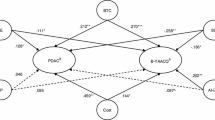Abstract
In this cross-sectional test of the occurrence of the abstinence violation effect (AVE), a community sample of 323 social drinkers completed measures of drinking restraint (perceived efficacy for controlling alcohol consumption and behavioral attempts to limit drinking) and causal attributions for drinking-related events. These measures were included as predictors in a multivariate multiple-regression equation in which three aspects of self-reported drinking served as dependent variables: minimum number of drinks per occasion, maximum number of drinks per occasion, and drinking-related problems. The results indicated differential sets of predictors for each of the dependent variables. Both aspects of restraint predicted minimum consumption, and both aspects of restraint and attributions for positive drinking situations predicted maximum consumption. Perceived efficacy for controlling alcohol consumption and attributions for negative drinking situations predicted alcohol-related problems. The consistency between this pattern of results and Marlatt's (1985a) reformulation of the AVE is discussed.
Similar content being viewed by others
References
Abramson, L. Y., Metalsky, G. I., & Alloy, L. B. (1989). Hopelessness depression: A theorybased subtype of depression.Psychological Review, 96, 358–372.
Abramson, L. Y., Seligman, M. E. P., & Teasdale, J. D. (1978). Learned helplessness in humans: Critique and reformulation.Journal of Abnormal Psychology, 87, 49–74.
Beck, A. T., Ward, C. H., Mendelson, M., Mock, J., & Erbaugh, J. (1961). An inventory for measuring depression.Archives of General Psychiatry, 4, 561–571.
Bentler, P. M., & Bonett, D. G. (1980). Significance tests and goodness of fit in the analysis of covariance structures.Psychological Bulletin, 88, 588–606.
Bray, J. H., & Maxwell, S. E. (1985).Multivariate analysis of variance.Beverly Hills:Sage
Burish, T. G., Maisto, S. A., Cooper, A. M., & Sobell, M. B. (1981). Effects of voluntary short-term abstinence from alcohol on subsequent drinking patterns of college students.Journal of Studies on Alcohol, 42, 1013–1020.
Cohen, J., & Cohen, P. (1983).Applied multiple regression/correlation analysis for the behavioral sciences. Hillsdale, NJ: Erlbaum.
Collins, R. L., George, W. H., & Lapp, W. M. (1989). Drinking restraint: Refinement of a construct and prediction of alcohol consumption.Cognitive Therapy and Research, 13, 425–442.
Collins, R. L., Parks, G. A., & Marlatt, G. A. (1985). Social determinants of alcohol consumption: The effects of social interaction and model status on the self-administration of alcohol.Journal of Consulting and Clinical Psychology, 53, 189–200.
Curry, S., Marlatt, G. A., & Gordon, J. R. (1987). Abstinence violation effect: Validation of an attributional construct with smoking cessation.Journal of Consulting and Clinical Psychology, 55, 145–149.
Curry, S. Southwick, L., & Steele, C. (1987). Restrained drinking: Risk factor for problems with alcohol?Addictive Behaviors, 12, 73–77.
Greenfield, T. K. (1986). Quantity per occasion and consequences of drinking: A reconsideration and recommendation.International Journal of the Additions, 21, 1059–1079.
Joreskog, K. G., & Sorbom, D. (1986).LISREL VI. Analysis of linear structural relationships by maximum likelihood, instrumental variables and least square methods. Mooresville, In: Scientific Software Inc.
Marlatt, G. A. (1985a). Cognitive factors in the relapse process. In G. A. Marlatt & J. R. Gordon (eds.),Relapse prevention (pp. 128–200). New York: Guilford Press.
Marlatt, G. A. (1985b). Cognitive assessment and intervention procedures for relapse prevention. In G. A. Marlatt & J. R. Gordon (eds.),Relapse prevention (pp. 201–279). New York: Guilford Press.
Marlatt, G. A., & Gordon, J. R. (1980). Determinants of relapse: Implications for the maintenance of behavior change. In P. O. Davidson & S. M. Davidson (eds.),Behavioral medicine: Changing health lifestyles (pp. 410–452). New York: Brunner Mazel.
National Institute on Alcohol Abuse and Alcoholism (1987).Sixth special report to the U.S. Congress on alcohol and health (DHHS Publication No. ADM 87-1195). Washington, DC: U.S. Government Printing Office.
Peterson, C., & Barrett, L. C. (1987). Explanatory style and academic performance among university freshmen.Journal of Personality and Social Psychology, 53, 603–607.
Peterson, C., & Seligman, M. E. P. (1984). Causal explanations as a risk factor for depression: Theory and evidence.Psychological Review, 91, 347–374.
Peterson, C., Semmel, A., von Baeyer, C., Abramson, L. Y., Metalsky, G. I., & Seligman, M. E. P. (1982). The Attributional Style Questionnaire.Cognitive Therapy and Research, 6, 287–300.
Ross, S. M., Miller, P. J., Emmerson, R. Y., & Todt, E. H. (1989). Self-efficacy, standards and abstinence violation: A comparison between newly sober and long-term sober alcoholics.Journal of Substance Abuse, 1, 221–229.
Ruderman, A. J., & McKirnan, D. (1984). The development of a Restrained Drinking Scale: A test of the abstinence violation effect among alcohol users.Addictive Behaviors, 9, 365–371.
Scheri-Perry, E. (1981).Development of a new Drinking Attributional Style Scale. Unpublished honors thesis, University of Wisconsin-Madison.
Seligman, M. E. P., & Schulman P. (1986). Explanatory style as a predictor of productivity and quitting among life insurance sales agents.Journal of Personality and Social Psychology, 50, 832–838.
Selzer, M. L. (1971). The Michigan Alcoholism Screening Test: The quest for a new diagnostic instrument.American Journal of Psychiatry, 127, 1653–1658.
Selzer, M. L., Vinokur, A., & van Rooijen, L. (1975). A self-administered Short Michigan Alcoholism Screening Test (SMAST).Journal of Studies on Alcohol, 36, 117–126.
Southwick, L., & Steele, C. M. (1987). Restrained drinking: Personality correlates of a control style.The Journal of Drug Issues, 17, 349–358.
Author information
Authors and Affiliations
Rights and permissions
About this article
Cite this article
Collins, R.L., Lapp, W.M. Restraint and attributions: Evidence of the abstinence violation effect in alcohol consumption. Cogn Ther Res 15, 69–84 (1991). https://doi.org/10.1007/BF01172943
Issue Date:
DOI: https://doi.org/10.1007/BF01172943




